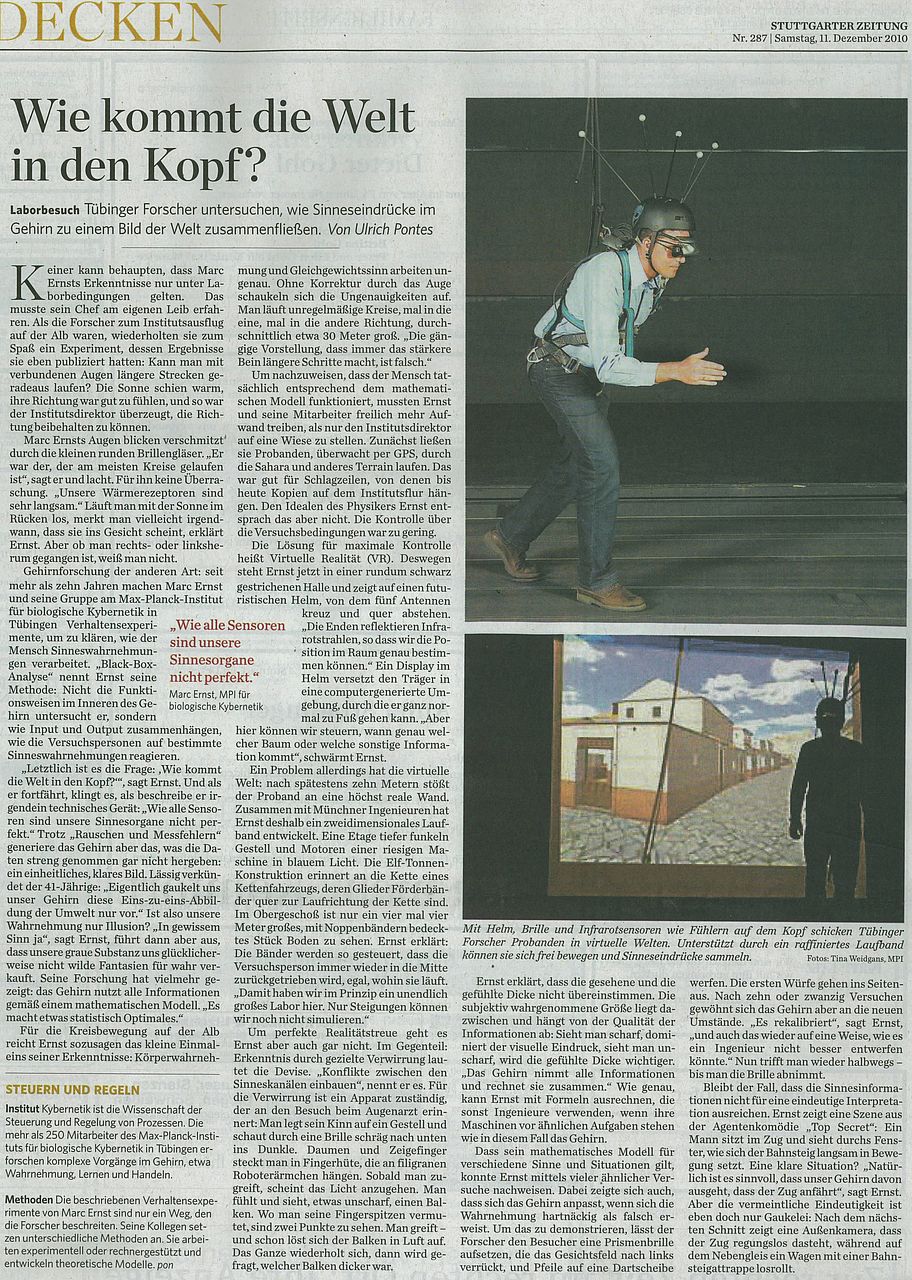Anbei ein Link zu einem Überblick der Publikationen auf: Google Scholar

Publikationen
Eine kleine Auswahl an 20 Publikationen:
| 1. | I Senna, CV Parise, MO Ernst. Modulation frequency as a cue for auditory speed perception. Proceedings of the Royal Society B 284; 1858, 20170673 (2017). |
| 2. | Parise, C. V., & Ernst, M. O. “Correlation detection as a general mechanism for multisensory integration” Nature Communications 7, 11543 doi:10.1038/ncomms11543 (2016). |
| 3. | Moscatelli, A., Bianchi, M., Serio, A., Terekhov, A., Hayward, V., Ernst, M. O., & Bicchi, A. “The Change in Fingertip Contact Area as a Novel Proprioceptive Cue” Current Biology 26 (9), 1159–1163 (2016). |
| 4. | Santello, M., Bianchi, M., Gabiccini, M., Ricciardi, E., Salvietti, G., Prattichizzo, D., Ernst M.O. et al. “Hand synergies: integration of robotics and neuroscience for understanding the control of biological and artificial hands” Physics of Life Reviews 17, 1–23 (2016). |
| 5. | Moscatelli, A., Bianchi, M., Serio, A., Terekhov, A., Hayward, V., Ernst, M. O., & Bicchi, A. “The Change in Fingertip Contact Area as a Novel Proprioceptive Cue” Current Biology 26 (9), 1159–1163 (2016). |
| 6. | Parise, C., Knorre, K., & Ernst, M.O. “Natural auditory scene statistics shapes human spatial hearing”. PNAS 111 (16), 6104–6108 (2014). |
| 7. | van Dam, L., & Ernst, M.O. “Knowing Each Random Error of Our Ways, but Hardly Correcting for It: An Instance of Optimal Performance”. PLOS ONE 8 (10), e78757–9 (2013) |
| 8. | Steinbach, E., Hirche, S., Ernst, M.O., Brandi, F., Chaudhari, R., Kammerl, J., Vittoeias I. “Haptic Communications”. Proceedings of the IEEE. Special Issue on Frontiers of Audiovisual Communications: New Convergences of Broadband Communications, Computing, and Rich Media 100 (4) 937-956 (2012). |
| 9. | Parise, C., Spence, C., & Ernst, M.O. When correlation implies causation in multisensory integration. Current Biology 22 (1), 46–49 (2012). |
| 10. | Rohde, M., M. Di Luca, & M.O. Ernst. The Rubber Hand Illusion: Feeling of Ownership and Proprioceptive Drift Do Not Go Hand in Hand. PLoS ONE, 6 (6), e21659 (2011). |
| 11. | Di Luca, M., M.O. Ernst and B. Backus: Learning to use an invisible visual signal. Current Biology 20 (20), 1860-1863 (2010). |
| 12. | Souman, J. L., I. Frissen, M. Sreenivasa & M. O. Ernst: Walking straight into circles. Current Biology 19 (18), 1538-1542 (2009). |
| 13. | Burge, J, Ernst, M.O., Banks, M.S. The statistical determinants of adaptation rate in human reaching. Journal of Vision 8 (4) Article 20, 1-19 (2008) |
| 14. | Ernst, M.O. Learning to integrate arbitrary signals from vision and touch. Journal of Vision 7 (5:7), 1-14 (2007). |
| 15. | Adams, W.J., E.W. Graf & M.O. Ernst: Experience can change “light-from-above” prior. Nature Neuroscience 7 (10), 1057-1058 (2004). |
| 16. | Ernst, M.O. and H.H. Bülthoff: Merging the Senses into a Robust Percept. Trends in Cognitive Science 8 (4), 162-169 (2004). |
| 17. | Hillis, J.M., M.O. Ernst, M.S. Banks and M.S. Landy: Combining sensory information: Mandatory fusion within, but not between, senses. Science 298, 1627-1630 (2002). |
| 18. | Ernst, M.O. and M.S. Banks: Humans Integrate Visual and Haptic Information in a Statistically Optimal Fashion. Nature 415, 429-433 (2002). |
| 19. | Newell, F.N., M.O. Ernst, B.S. Tjan and H.H. Bülthoff: Viewpoint Dependence in Visual and Haptic Object Recognition. Psychological Science 12 (1), 37-42 (2001). |
| 20. | Ernst, M.O., M.S. Banks and H.H. Bülthoff: Touch can change visual slant perception. Nature Neuroscience 3, 69-73 (2000). |
Auszug aus Stuttgarter Zeitung vom 11. Dez. 2010:

Auszug aus der Nürnberger Zeitung vom 01. April 2017

